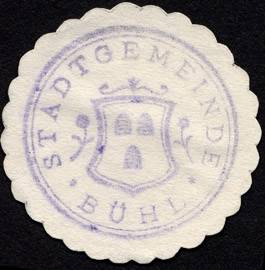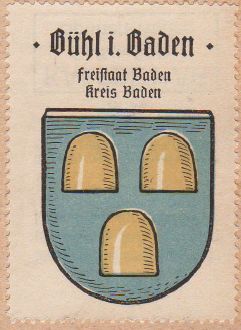Bühl (Baden): Difference between revisions
Jump to navigation
Jump to search
Knorrepoes (talk | contribs) m (Text replace - "'''Official blason:'''<br>" to "====Official blazon====") |
Knorrepoes (talk | contribs) m (Text replace - "|width="15%"|50 px|right |}" to "|width="15%"|50 px|right |}<seo title="Wappen, Gemeindewappen" />") |
||
| Line 3: | Line 3: | ||
|width="70%" align="center" |'''Heraldry of the World<br/>Civic heraldry of [[Germany]] - [[Deutsche Wappen|Deutsche Wappen (Gemeindewappen/Kreiswappen)]]''' | |width="70%" align="center" |'''Heraldry of the World<br/>Civic heraldry of [[Germany]] - [[Deutsche Wappen|Deutsche Wappen (Gemeindewappen/Kreiswappen)]]''' | ||
|width="15%"|[[File:Germany.jpg|50 px|right]] | |width="15%"|[[File:Germany.jpg|50 px|right]] | ||
|} | |}<seo title="Wappen, Gemeindewappen" /> | ||
Revision as of 16:54, 5 November 2012
| Heraldry of the World Civic heraldry of Germany - Deutsche Wappen (Gemeindewappen/Kreiswappen) |
BÜHL
State : Baden-Württemberg
District (Kreis) : Rastatt (until 1972 Bühl)
Additions : 1934 Kappelwindeck, 1972 Altschweier, Balzhofen, Eisental, Moos, Neusatz (1936 Waldmatt), Oberbruch, Oberweier, Vimbuch, Weitenung
Official blazon
In Blau drei (2:1) goldene Bühel (Hügel).
Origin/meaning
Bühl was already a town in the 13th century and the oldest seal dates from the early 15th century. On the oldest seal the canting hills (from Bühel or Hugel, hill) can already be seen.
| Seals of Brühl from 1409 and 1643. |
The arms thus never really changed and were finally officially approved in 1900. During the 19th century the hills were sometimes seen as beehives, and shown as such.
| Seal from around 1900 |
The arms in the Kaffee Hag albums +/- 1925 |
Literature : Stadler, K., 1964-1971; Zier, 1964.



